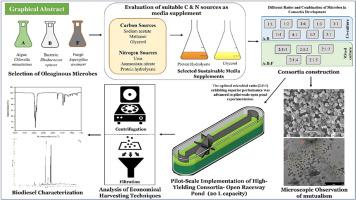Tailoring mixed microbial consortia for sustainable biodiesel: An attempt towards synergistic biomass production and cost-effective harvesting in pilot scale open cultivation
IF 5.8
2区 化学
Q2 CHEMISTRY, MULTIDISCIPLINARY
引用次数: 0
Abstract
Biodiesel has emerged as a viable alternative to traditional fossil fuels due to the growing need for sustainable energy sources. Microbial mixed-culture system was developed to avoid sterile and extremely harsh conditions practised in open algal cultivation. A series of culture conditions, including the suitable supplementation, inoculum and C/N ratios, were optimised to establish a robust and stable consortia. Optimal conditions yielded a maximum of 3.17 ± 0.27 g/L and 2.98 ± 0.16 g/L (a 2.36- and 2.32-fold increase) in biomass with a lipid content of 26 % and 22 % (a 2.89- and 2.56-fold increase in lipid) using Chlorella minutissima and C. vulgaris mediated mixed cultures, respectively, in an open cultivation than in axenic cultures. The photosynthetic microalgae form a mutualistic relationship with heterotrophic Rhodococcus sp. and Aspergillus sp. through O2/CO2 exchange. Supportive growth of microbes in consortia was visualised through microscopic observations. The constructed consortium demonstrated a substantial increase in biomass; its efficacy under open-cultivation was systematically evaluated in a pilot-scale open pond of 20-L. The consortia enabled a significant reduction of 75–83 % in harvesting costs, 3.62- to 6.23-fold reduction compared to axenic cultures. This work presents a practical approach for large-scale, sustainable microalgal cultivation that leverages cost-efficient nutrient sources and enhanced process economics. Notably, the fatty acid content analysed through gas chromatography resulted in considerable alteration in methyl ester produced through axenic and mixed culture systems in both closed and open conditions, with the majority of composition being C16-palmitic, C18-stearic and C18:1-oleic acids, validating its suitability for biodiesel application, matching the standard requirements.

为可持续生物柴油量身定制混合微生物群落:在中试规模开放栽培中实现协同生物质生产和成本效益收获的尝试
由于对可持续能源的需求日益增长,生物柴油已成为传统化石燃料的可行替代品。开发了微生物混合培养系统,以避免开放式藻类培养中无菌和极端恶劣的条件。优化了一系列培养条件,包括适宜的添加量、接种量和C/N比,以建立强大而稳定的菌落。在开放培养条件下,与无菌培养相比,微小小球藻和普通小球藻混合培养的生物量最高可达3.17±0.27 g/L和2.98±0.16 g/L(分别增加2.36倍和2.32倍),脂质含量分别为26%和22%(分别增加2.89倍和2.56倍)。光合微藻通过O2/CO2交换与异养红球菌(Rhodococcus sp.)和曲霉(Aspergillus sp.)形成共生关系。通过显微镜观察,可以看到群落中微生物的支持性生长。构建的联合体显示出生物量的大幅增加;在20 l的中试露天池塘中,系统评价了其在露天栽培下的效果。该联盟使收获成本显著降低75 - 83%,与无菌培养相比降低了3.62- 6.23倍。这项工作提出了一种大规模、可持续的微藻培养的实用方法,利用成本效益高的营养来源和增强的过程经济。值得注意的是,通过气相色谱分析的脂肪酸含量导致封闭和开放条件下无菌和混合培养系统产生的甲酯发生了相当大的变化,大部分成分为c16 -棕榈酸、c18 -硬脂酸和c18:1-油酸,验证了其适用于生物柴油的适用性,符合标准要求。
本文章由计算机程序翻译,如有差异,请以英文原文为准。
求助全文
约1分钟内获得全文
求助全文
来源期刊

Sustainable Chemistry and Pharmacy
Environmental Science-Pollution
CiteScore
8.20
自引率
6.70%
发文量
274
审稿时长
37 days
期刊介绍:
Sustainable Chemistry and Pharmacy publishes research that is related to chemistry, pharmacy and sustainability science in a forward oriented manner. It provides a unique forum for the publication of innovative research on the intersection and overlap of chemistry and pharmacy on the one hand and sustainability on the other hand. This includes contributions related to increasing sustainability of chemistry and pharmaceutical science and industries itself as well as their products in relation to the contribution of these to sustainability itself. As an interdisciplinary and transdisciplinary journal it addresses all sustainability related issues along the life cycle of chemical and pharmaceutical products form resource related topics until the end of life of products. This includes not only natural science based approaches and issues but also from humanities, social science and economics as far as they are dealing with sustainability related to chemistry and pharmacy. Sustainable Chemistry and Pharmacy aims at bridging between disciplines as well as developing and developed countries.
 求助内容:
求助内容: 应助结果提醒方式:
应助结果提醒方式:


